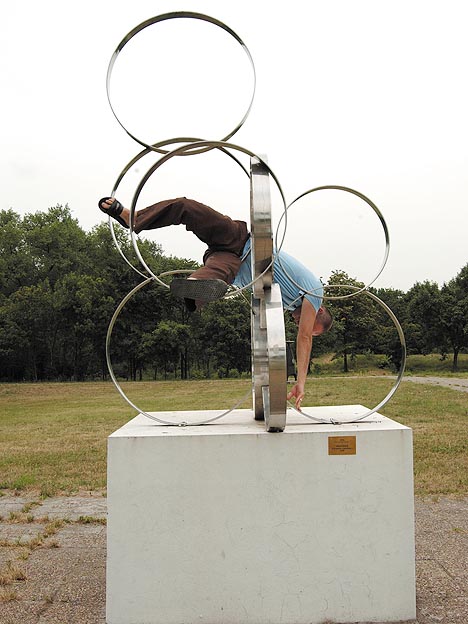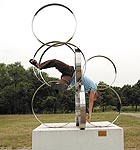
translated and summarized by: Liz Wollner-Grandville,
English summary September 7 - 13
Bawag Contemporary: Young and Reckless 10: Marko Lulic – Historic preservation and Bodywork 2
On the playground of Modernism
Did anybody discover how well modern sculpture qualifies as a playground device - before Marko Lulic did? In his slide show work “Reactivation (Circulation of Space)” the artist does gymnastics on a sculpture created by Vojin Bakic in 1971, which consists exclusively of rings and is located in front of the Museum of Contemporary Art in Belgrad; he wreathes and wriggles staccato-like through the individual elements, which were definitely not designed for that.
In another video, a remake of Raquel Welch’s clip “Space Girl Dance” Lulic uses large sculptures for something they were not intended for: similar to the way the actress danced through a Mexican sculpture park, he staged three dancers (one female, two male) into the work of the German sculptor Erich Hauser – the partly amorphous works of the original gave way for more snappy metal creations, the melodic soundtrack of the 1970s yielded the hammering score by Mario Neugebauer. At the beginning, Lulic presents a sculpture in rapidly moving close-ups, as if they were not only backdrop objects, but also a vital part of the game. This is a feature in Avant-garde stage settings: Lulic’s preferred object of investigation. The mixture of sculpture, futuristic outfit and pressing soundtrack lets art appear as a better disco ball – simultaneously praising its aesthetic qualities.
Unfortunately, the music disturbs the silence, which the adjoining video would desperately need: it shows an artist dancing for four hours – luckily cut down to 20 minutes – to an inaudible playlist put together by friends – with remarkable comedian-like qualities, and at the same time increasingly distressed strategies in an attempt to hang on; a work, which moves in a wide reference system between Bruce Naumann and Peter Land, but – although nice to look at – does not win any content depth; in contrast to those works, in which Lulic ploughs through his familiar terrain – Modernism.
By Nina Schedlmayer
Bawag Contemporary
1060 Vienna, Barnabitengasse 11 – 13, until 04.10.09
www.bawagcontemporary.at
Fondation Cartier pour lart contemporain: Né dans la rue – Graffiti
On brotherhood, rebellion, criminalization and entry into a museum
“male
black, puerto rican, other
13 – 16 years
carries package or paper bag, long coat in cold weather
time of day: 4 pm to 2 am, after school hours”
- this was written by the New York police in the 1970s and is presented at the exhibition “Né dans la rue – Graffiti” at the Fondation Cartier in Paris. Obviously these short lines document a dramatic increase of arrests (707) of male graffiti sprayers in 1972; in the following years the number doubled.
The exhibition, presented in a historic context, transmits the American way of life of the young sprayers from the end of the 1970s to the early 80s. The sprayer Alan Ket provides authenticity and access to the scene. He appealed to the public following numerous notices and the threat of a ten-year prison sentence. This form of self-authorized acting in public space, with a huge audience that doesn’t visit museums often, still calls for criminalization and the attribution to vandalism.
The short videos, which were especially created for this exhibit, clearly show what the kick was: “becoming famous in overwriting others” (original words by MICO, who became legendary with “Hang Nixon”) and “to get up and do the best that you can”.
The exhibition attempts to review the former underground culture by presenting a bizarre mixture of “peculiarities” – such as Richard Miranda’s aka Seen original work clothes (camouflaged in a subway workman’s outfit) or the bathroom door covered with 190 tags by the graffiti-pioneer Jack Stewart, as well as descriptions of individual writings. The now “grown up” players are forthwith officially presented as artists, familiar elements from the public space are herewith introduced into an art context.
The organizers assured that this had nothing to do with institutionalizing the graffiti work. On the contrary, the invited artists were pleased that their work was being seen and heard, and were allowed to freely dispose of their work at the end of the show.
By allocating the outside walls for writings of all kinds, the organizers strive to include a pinch of the unpredictable and the original esprit. And even if Bansky is missing, the films “Downtown 81” and “Wild Style”, including all of the associated music groups of those days, are shown.
A flyer, dating from 1985 with “Names of those “enclosed” died before 23” deals with the hardship that sprayers were faced with; at a time during which none of the then not more than15-year olds ever dreamed they would be part of an exhibition. Blade meticulously lists how and when the artists died while exercising their “aerosol art”. The internal police description calls this the “hazard factor”: “Several youths injured by third rail or moving train resulting in their deaths”.
By Fiona Rukschcio
Fondation Cartier pour lart contemporain
75014 Paris, 261 boulevard Raspail, until 29.11.09
www.fondation.cartier.fr
O.K. Offenes Kulturhaus Oberösterreich: Cyberarts 2009 – Prix Ars Electronica Exhibtion
In the normality of real-time world
High tech goes low tech. Welcome to the world of experiments and handicraft, of hobby gardening and weaving. Who would have ever expected that the digital art exhibit Cyberart, would present itself so casually - at least on the level of analogue, not at all computer-like materializations. This world of cool surfaces now only partially manifests itself at the O.K. in Linz, something which had a statement character in the early days of the ars electronica.
This year, the ars electronica jury put forth social and ecological aspects. Among the works shown is an installation, which was already presented at the Manifesta in Bozen: ‘Tantalum Memorial Residue’ by Graham Harwood, Richard Wright (UK) and Matsuko Yokokoji (UK/JP). It is based on old analogous telephone circuits and enables setting up a complex social network through recorded language, which is dedicated to the refugees from the Congo as a communicative sculpture. Content wise, the installation, which was created in England and resembles a fragment of an archaic switchboard, refers to the exploitation of coltan ore in the Congo. The metal tantalum, which is extracted from coltan, is used in the production of cell phones.
Yuri Suzuki’s “The Physical Value of Sound,” presents a series of interactive sound installations based on the good old vinyl records. And a similar re-translation is displayed in Matthias Gommel’s, Martina Haitz’s and Jan Zappe’s installation ‘robotlab’, in which an industrial robot transcribes all 66 books of the Bible onto paper roles over a period of many months.
Large parts of this year’s Cyberart can be summarized at the level of recording systems in the sense of representation automats, which function through their immanent technological time jumps in a media reflective way. Of course the creaking and cracking of these old appliances is accompanied by the more current processing of classics at the interface into an uncertain future. Topics such as hybrid architecture or biotechnology are presented: Eduardo Kac’s decoded DNS, which leaves its traces in an herbal blossom or Shiho Fukohara and Georg Tremmel’s genetically altered carnation “Moondust”.
Unfortunately some of the works are only presented as documentations or as implemented trace elements. Now, especially through the opening of the extended ars electronica centre, the question arises, how the ars electronica will succeed to offensively develop and discuss new art terms in the future. This would be connected to the acknowledgement of more costly presentations - and possibly productions.
The extent of the efforts the festival has made in the last 30 years to establish electronic and digital culture is presented in the retrospective part of the Brucknerhaus in Linz. Here you will find a documentation how the “ars” gradually developed into an independent event and emerged from the Linzer Brucknerfest. And here, in the world of a past future, one encounters the media art pioneer Zelko Wiener, who died in 2006. Already during the mid 80s he anticipated the concept of today’s Internet on the basis of the telephone BTX technology. To a certain degree, this is where the other end of the parabola is located.
By Roland Schöny
O.K. offenes Kulturhaus Oberösterreich
4020 Linz, Dametzstrasse 30, until 04.10.09
www.ok-centrum.at
MAK-Ausstellungshalle: Global:Lab – Art as a message. Asia and Europe 1500 – 1700
Early globalisation as an intellectual adventure
Even today Immanuel Wallerstein’s study on the development of a European world economic system starting around 1450, the “The Modern world System” (1974) influences our debates on globalisation.
Gradually those forms of visualisation found in the large storerooms of classic art, which not only depict expeditions, conquests, and slavery, but also reflect processes of the mixing of diverse cultures, undergo a critical reading and new interpretations.
Parallel to the development of central perspectives in the Arab world and in Europe, as well as the new technical methods of measuring the world and their epochal effects on the occidental art history, numerous new methods of measuring as well as the adoption of new forms of perception and interpretations of the world were developed.
With the large exhibition “Global: Lab - Art as a message. Asia and Europe 1500 – 1700, the MAK focuses on these developments.
The show documents how strong the impact of the transfer of art strategies as well as scientific research results was for the respective other cultural production in Europe – for example in the Netherlands – and, on the other hand, in Asia with the Chinese emperor’s court as an example. This is represented by a 17th century twelve part chestnut-coated folding screen depicting Dutch seamen bringing exotic animals and treasures to the coast to load them onto a ship, which was interpreted as a Dutch delegation to the Chinese emperor’s court.
The sensation at this exhibit is a sequence of the famous “Hamza-Nama”, a 16th century mogul landscape, which is one of the most important works of painting of the Islamic world. 200 of the originally 1.400 sheets are still persevered today. With 60 miniatures, the MAK owns the largest connected stock. Another topic at this exhibit,which was put together by Angela Völker and Johannes Wieninger, deals with strategies of cultural identity construction – for example, the confrontation of the ideal type of a European according to Dürer’s proportional studies and its interaction with the ornament and narrative illustration of the Islamic culture.
The main features of the exhibition architecture, staged by Michael Embacher, remind of a system of opened transportation cases, partially consisting of synthetic and foamed material; something that is more or less standard these days.
In general, this is a highly recommendable exhibition; not only to study essential parameters of cultural globalization, but also because the potentials of the MAK collection become visible. The “Museum as a time machine” is revived in an exhibition that can be described as an intellectual adventure.
By Roland Schöny
MAK-Ausstellungshalle
1010 Vienna, Weiskirchnerstrasse 3, until 27.09.09
www.mak.at
Mehr Texte von translated and summarized by: Liz Wollner-Grandville


 Teilen
Teilen





